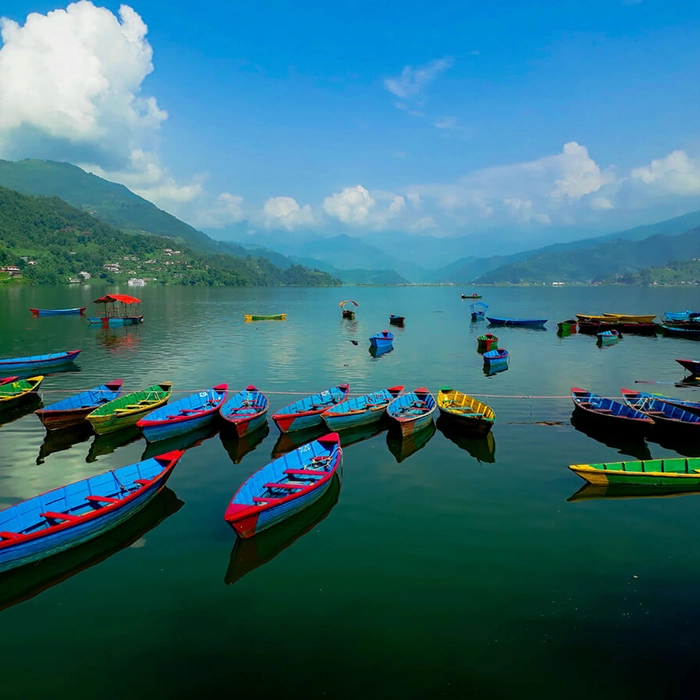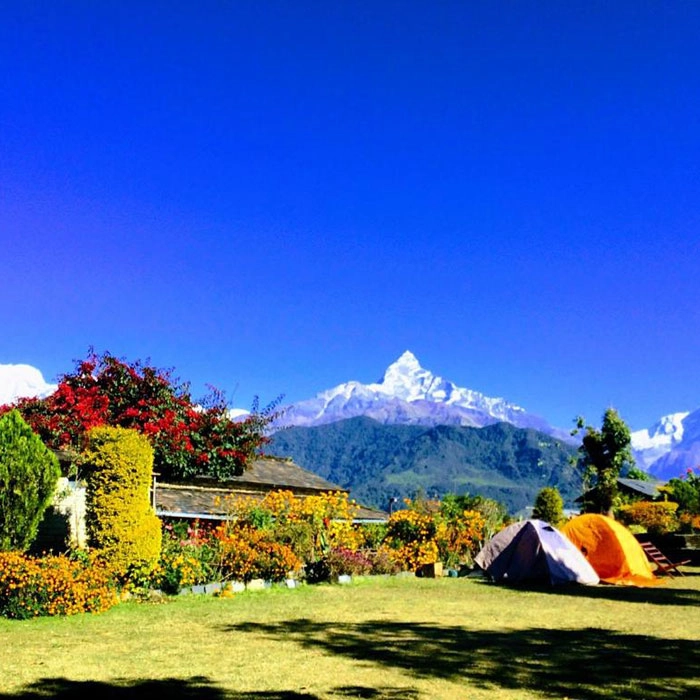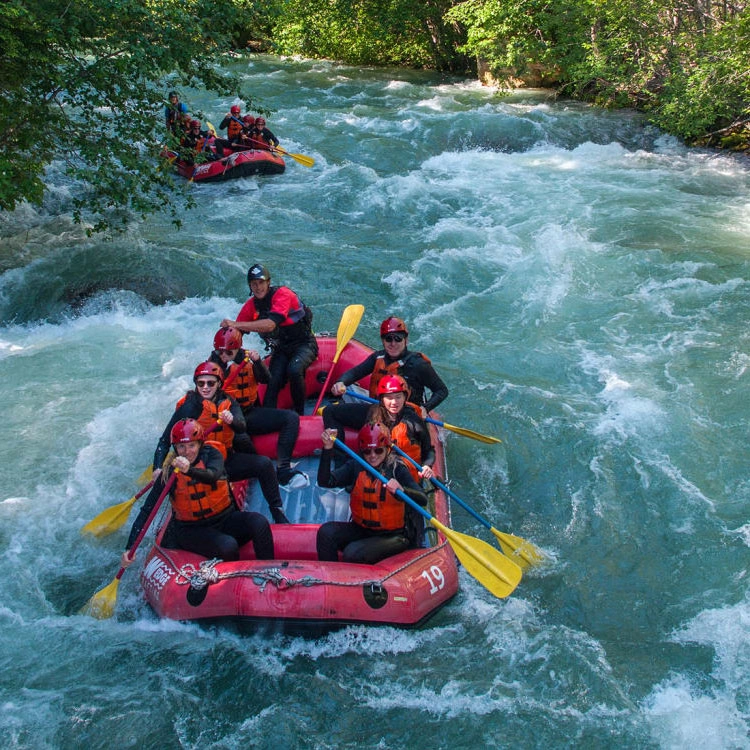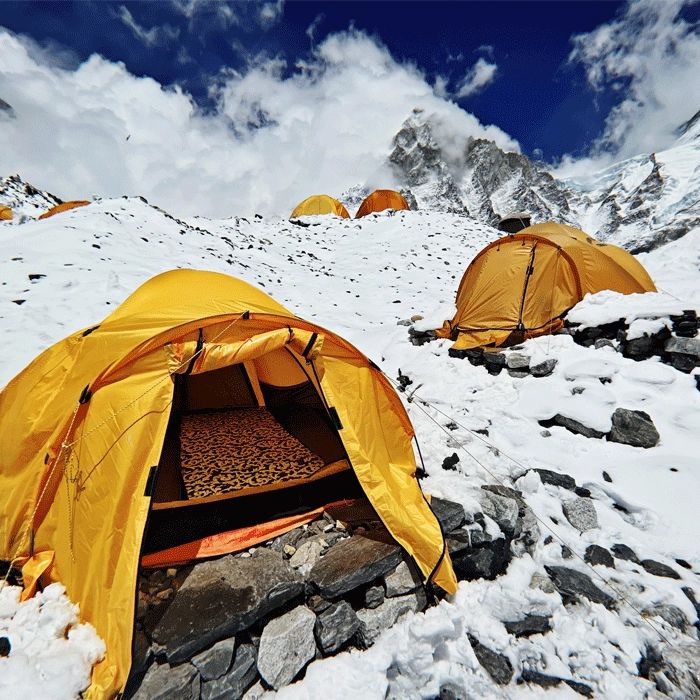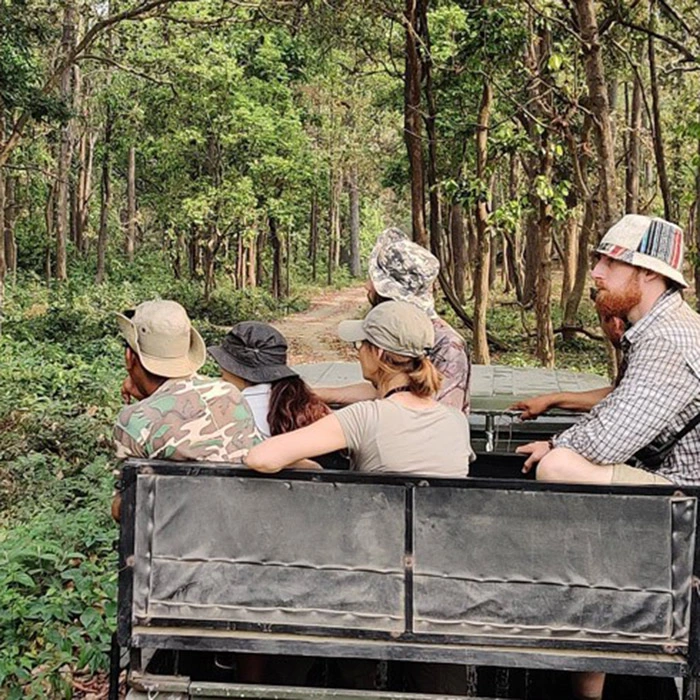EVEREST THREE PASSES TREK
US$2,430.00
/pp
-
21 Days
-
Everest
-
Spring/Autumn
-
Trekking
-
5,550 Meters
-
Hard
-
Car/Plane
-
01-16 People
-
JH#225
 Overviews
Overviews
The Everest Three Passes Trek is the ultimate Himalayan circuit, designed for experienced and adventurous trekkers seeking a high-altitude challenge and a complete exploration of the Everest region. This 21-day Everest Three Passes Trek journey offers a thrilling blend of scenic grandeur, cultural richness, and physical endurance, taking you through the three major high passes of the Khumbu: Kongma La (5,535m), Cho La (5,420m), and Renjo La (5,360m).
Beginning your Everest Three Passes Trek with a dramatic flight to Lukla, the trail leads you through iconic Sherpa settlements such as Namche Bazaar, Tengboche, Dingboche, Gokyo, and Thame, where you can immerse yourself in local Himalayan culture and hospitality. Along the way, you’ll witness the breathtaking beauty of Mount Everest, Ama Dablam, Lhotse, Makalu, and Cho Oyu, visible from numerous high-altitude vantage points including Kala Patthar (5,550 m) and Gokyo Ri (5,360m).
In addition to visiting Everest Base Camp (5,364m) and the mesmerizing Gokyo Lakes in this Everest Three Passes Trek, the Everest Three Passes Trek also takes you through dramatic glacial valleys, alpine deserts, high mountain passes, and spiritual landmarks like ancient monasteries and mani walls. The journey is carefully designed with proper acclimatization days to reduce the risk of altitude sickness and ensure a safer, more enjoyable experience.
Unlike the standard Everest Base Camp trek, the Everest Three Passes route follows a loop, eliminating the need to retrace your steps and allowing you to explore more of the remote and less-crowded corners of the Khumbu region. The combination of scenic trails, heart-pounding ascents, and authentic cultural encounters makes this one of the most rewarding treks in Nepal.
Perfect for those with excellent fitness and a spirit of adventure, the Everest Three Passes Trek is a physically demanding but unforgettable journey into the world’s most majestic mountains. With professional guides, comfortable teahouse accommodations, and full logistical support, this trek offers a once-in-a-lifetime experience that goes far beyond the ordinary. Everest Three Passes Trek DifficultyThe Everest Three Passes Trek is regarded as one of the most challenging treks in the Everest region, recommended for experienced trekkers with strong physical fitness and prior high-altitude trekking experience. The route crosses three high mountain passes — Kongma La (5,535m), Cho La (5,420m), and Renjo La (5,360m) — each involving long, steep ascents and descents, often over rocky or icy terrain. Trekkers typically hike 6 to 9 hours per day, with multiple days spent above 4,500 meters, increasing the risk of altitude-related issues. Due to its demanding nature, rugged trails, and extended duration, this trek requires excellent stamina, acclimatization, and mental resilience. For those well-prepared, it offers unmatched views and a complete circuit of the Everest region. Everest Three Passes Trek CostThe Everest Three Passes Trek cost generally includes all key services such as a licensed trekking guide, porter support, Sagarmatha National Park and local permits, teahouse accommodation, three meals per day during the trek, and domestic flights between Kathmandu and Lukla. Because of its longer duration and remote, high-altitude route, this trek tends to cost slightly more than standard Everest Base Camp packages. Solo trekkers enjoy personalized service, while groups benefit from discounted rates based on size. We also offer seasonal discounts during off-peak months. While our website displays general global pricing, you can contact us directly for custom group quotes. We ensure the best possible rate without compromising on safety, comfort, or service quality for this epic Himalayan circuit.
 Itinerary (Plan)
Itinerary (Plan)
Arrive in Kathmandu, Nepal's vibrant capital, where you'll be warmly welcomed with marigold garlands. After transferring to your hotel, take time to relax and acclimate to the bustling city. Discover vibrant local markets, indulge in traditional Nepali dishes, and delve into Kathmandu's rich cultural tapestry. This initial day is perfect for easing into your journey, setting the stage for the exciting adventures ahead in Eastern Nepal. A representative from Jagadamba Holidays will ensure a smooth and pleasant arrival.
Optional Evening Activity:
If you wish, you can spend your evening experiencing the Pashupatinath Aarti, a captivating religious ceremony held at the Pashupatinath Temple. The Aarti usually begins around 6:00 PM and lasts for approximately an hour. This ceremony is a mesmerizing display of traditional music and rituals, providing a profound insight into Hindu spiritual practices. Please check the exact time for the Aarti on the day of your visit, as it may vary. This option is not included in the standard itinerary but offers a unique opportunity to immerse yourself in local culture.
Normally, we book a flight from Kathmandu to Lukla (2,846 m / 9,350 ft.); however, if we are unable to secure a direct flight for some reason, we will need to take an alternative flight option via Ramechhap. If our flight to Lukla is scheduled from Manthali and we have extra time, we will explore the Kathmandu Valley before driving to Manthali for an overnight stay. However, if time is limited, we will depart from Kathmandu at 2 AM to catch the flight on Day 2. This will take approximately four hours to cover the distance of 132 kilometers to Manthali.
This early departure ensures that we arrive in time for the first flight from Ramechhap to Lukla, which departs at 6:30 AM. We will leave Kathmandu according to our scheduled departure time to guarantee a smooth journey to the airport.
Upon arrival at Lukla, your guide will introduce you to your porter. After a brief tea break, we will commence our trek to Phakding (2,620 m / 8,595 ft.). Phakding, a picturesque village and the largest settlement in the area, serves as an ideal first stop for many trekkers spending their initial night in the mountains. Once you arrive in Phakding, you'll enjoy a one-hour break to relax and take in the stunning surroundings. It is recommended to meet with your guide in the lobby afterward to discuss the evening's activities and the schedule for the following day.
Following your refreshment break at Lukla, embark on your trek to Phakding, traversing the scenic route through Nurning Ghat (2,590 m). The trek covers about 8.5 kilometers and takes approximately 3 to 4 hours. During this journey, you will ascend 190 meters and descend 380 meters.
After your breakfast at the lodge, embark on your trek to Namche Bazaar (3,440 m / 11,286 ft.), traversing the scenic route through Monjo (2,835 m). The trek covers about 9.5 kilometers and takes approximately 5 to 6 hours. During this journey, you will ascend 860 meters and descend 190 meters.
We embark on a picturesque trek in the Khumbu region along the Dudh Koshi River. Here, we'll cross stunning suspension bridges adorned with colorful prayer flags. As we navigate the trail, we pass through charming Sherpa villages and lush rhododendron forests, steadily ascending while soaking in breathtaking views of majestic snow-capped peaks.
This journey offers both beauty and challenge, making every step worthwhile. Upon reaching Namche Bazaar (3,440 m / 11,286 ft.), the largest Sherpa village and a vital trading hub, we’ll have ample opportunity to acclimatize to the altitude.
Namche Bazaar's vibrant market is bustling with shops, cafes, and bakeries, creating a lively atmosphere against the dramatic Himalayan backdrop. After checking into our lodge, you can relax, hydrate, and enjoy a warm meal. In the evening, we’ll gather with our group to share stories and reflect on the day’s adventures, setting the stage for an exciting acclimatization day ahead.
This trek from Phakding to Namche Bazaar not only showcases stunning vistas but also immerses you in the rich Sherpa culture, making it a memorable part of your Everest Base Camp journey.
Make the most of your rest day in Namche Bazaar by acclimatizing to the altitude and immersing yourself in the stunning beauty of the Khumbu region. After a hearty breakfast, you can either explore the vibrant town of Namche or embark on an optional scenic trek to Khunde, passing through Khumjung village, with a stop at the renowned Everest View Hotel (3,880 m / 12,730 ft.).
This picturesque hike to Khunde offers breathtaking views of the world’s tallest peaks, including Mount Everest, Lhotse, and Ama Dablam. The well-marked trail is relatively steep, rewarding trekkers with panoramic vistas and ample opportunities for memorable photographs. At the Everest View Hotel, take a moment to pause for refreshments while soaking in the magnificent surroundings before continuing your journey to Khunde, a charming Sherpa village rich in culture and history.
Once in Khunde, explore local attractions such as the Sherpa museum and historic monasteries, which showcase the unique heritage of the Sherpa people. After your trek, return to Namche Bazaar for a leisurely lunch and some free time to visit local shops, purchase trekking gear, or unwind at a cozy café with stunning mountain views.
In the evening, gather with your group to share stories from your day and enjoy a warm meal together. This day of exploration and acclimatization not only enriches your experience in the Himalayas but also prepares you for the exciting adventures that lie ahead.
The round-trip trek from Namche Bazaar to Khunde via the Everest View Hotel and Khumjung covers approximately 8.15 kilometers and typically takes 5 to 6 hours. During the journey, you will ascend 550 meters and descend 550 meters.
After breakfast at the lodge in Namche Bazaar, embark on your trek to Thame (3,820 m / 12,533 ft.), a journey that promises a deep dive into the rich Sherpa culture alongside breathtaking Himalayan landscapes. The trail winds through lush forests and offers panoramic views of iconic peaks such as Mt. Everest and Ama Dablam.
As you trek toward Thame, you will first pass through the charming village of Thamo, where traditional Sherpa houses and the warm hospitality of the locals greet you. Continuing on, you will reach Phurte (3,650 meters), where you can observe daily life and immerse yourself in the vibrant community.
The trail follows the picturesque Bhote Koshi River valley, meandering through rhododendron forests and crossing suspension bridges, with the stunning backdrops of Thamserku and Kangtega.
Reaching Thame at 3,820 meters, you will discover its historic significance in mountaineering. The village's narrow alleys are adorned with prayer flags and traditional stone houses, showcasing the unique architectural style of the region. Take the opportunity to visit the revered Thame Monastery, which dates back centuries, and soak in the serene atmosphere while enjoying views of towering peaks like Teng Kangpoche and Kwangde.
Throughout the trek, prioritize acclimatization by taking breaks as needed and staying hydrated. Prepare for changing weather conditions by carrying appropriate gear and snacks, as amenities along the route may be limited. The trek from Namche to Thame, covering a distance of 9 kilometers, typically takes 4 to 5 hours, with an elevation gain of 560 meters and a descent of 220 meters.
In conclusion, this trek is not just a journey through stunning landscapes but also an enriching experience that allows you to connect with the vibrant Sherpa culture and the natural beauty of the Khumbu region.
After breakfast at the lodge, embark on a scenic trek from Thame to Lungden (4,370 m / 14,337 ft), passing through the peaceful and less-frequented village of Marulung (4,210 m). The trek journey covers 10 kilometers and takes around 5 to 6 hours. During this journey, you will ascend 620 meters and descend 40 meters.
This segment of the trail provides a distinctive experience, away from the more frequented routes, enabling trekkers to immerse themselves in the pristine beauty of the region. The trek fosters a deeper connection with the local Sherpa culture, enhancing your understanding of their traditions and way of life. As you traverse the trail, you will be captivated by the stunning landscapes, including verdant valleys, rugged mountains, and pristine rivers that characterize this part of the Himalayas.
As the trek begins, the path follows the meandering Bhote Koshi River, offering stunning views of the deep river valley below. The gentle ascent provides the perfect opportunity to take in the surrounding natural beauty, from snow-capped peaks to rolling hills adorned with alpine vegetation. Along the way, you may encounter local yak herders guiding their animals along the rugged mountain paths, offering a glimpse into the traditional way of life in the Khumbu region.
Passing through Marulung, a quiet village that exudes timeless charm, you’ll notice the traditional stone houses and terraced fields that have sustained Sherpa families for generations. The peaceful ambiance of Marulung, with its surrounding fields and distant mountain vistas, invites you to pause and reflect on the remote beauty of the Himalayas. This area is rich in both history and culture, as it lies on an ancient trade route between Tibet and Nepal, where locals once traded salt and wool.
As you continue toward Lungden, the landscape becomes more barren and rugged, reflecting the higher altitude and harsher climate. Lungden, perched at 4,380 meters, offers a sense of isolation and tranquility that is rare to find. This village serves as an important acclimatization stop for trekkers heading toward the famous Renjo La Pass. From Lungden, enjoy expansive views of some of the region’s highest peaks, creating a breathtaking backdrop against the clear mountain skies.
In the evening, take time to explore the village and interact with the friendly locals, who will gladly share stories about their culture and traditions. Lungden provides the perfect opportunity to rest and prepare for the next stage of your Himalayan adventure.
Enjoy your leisure day by resting in the lodge or exploring the historic trade route in and around Lungde towards Tibet. Seize the opportunity of your well-deserved rest day in Lungde to discover the unique charm of this Himalayan village and its rich history. Lungde has long served as an important stop for trekkers and traders on the ancient trade route between Tibet and Nepal, facilitating the exchange of goods and cultural practices. This historical significance is reflected in the local architecture and the enduring traditions of the Sherpa people.
Wander through Lungde, interacting with local Sherpa residents and gaining insights into their daily lives and cultural traditions. Visit the village monasteries to experience the spiritual ambiance and observe religious rituals, if possible. Consider embarking on a short hike to nearby viewpoints that offer stunning panoramas of the surrounding mountains and valleys. Alternatively, take time to relax and soak in the serene mountain scenery, perhaps engaging in yoga or meditation to connect with the natural environment.
Capture the beauty of Lungde through photography, showcasing the unique architecture and breathtaking landscapes. Whether engaging in cultural activities, hiking, or simply unwinding amidst the tranquil setting, make the most of your rest day in Lungde, immersing yourself in the Himalayan experience and rejuvenating for the remainder of your trek.
Embarking on a trek over Renjo La Pass (5,360 m / 17,585 ft.) and continuing to Gokyo (4,790 m / 15,715 ft.) offers a thrilling and picturesque adventure in Nepal's Everest region. This exhilarating journey covers approximately 11 kilometers and typically takes between 7 to 8 hours. During this trek, you will ascend 990 meters and descend 610 meters.
The day begins with an early start from Lungde, which serves as the base for the Renjo La Pass, leading to a challenging ascent over rocky terrain. As you climb higher, panoramic views of Everest, Lhotse, Makalu, and other Himalayan giants unfold, providing a breathtaking backdrop for your adventure. Upon reaching the summit of Renjo La Pass, adorned with fluttering prayer flags, you'll be rewarded with stunning 360-degree vistas, including the mesmerizing Gokyo Lakes shimmering below.
After taking in the stunning scenery, the trail descends steeply into the Gokyo Valley, offering glimpses of the expansive Ngozumpa Glacier along the way. The descent requires careful footing as you navigate the rugged terrain. Eventually, you will arrive in Gokyo, a charming village nestled by the shores of the serene Gokyo Lakes. Here, you can unwind and settle into your accommodation, surrounded by the tranquility of this breathtaking Himalayan landscape.
While in Gokyo, consider exploring further by hiking up to Gokyo Ri (5,360 meters) for incredible views of Everest and its neighboring peaks reflected in the turquoise waters of the Gokyo Lakes. Alternatively, take a leisurely stroll around the lakeshores, soaking in the natural beauty of this pristine alpine setting. Remember to prioritize acclimatization, stay hydrated, and savor every moment of this unforgettable trekking experience in the Everest region.
After your breakfast at the lodge, begin your well-deserved rest day for acclimatization by immersing yourself in the serene beauty of the Everest region. This day provides an essential opportunity for your body to acclimatize to the high altitude, allowing you to enjoy tranquil moments in your lodge or teahouse. Reflect on your journey thus far, journal your experiences, or simply enjoy the breathtaking mountain views surrounding you.
For those seeking a bit of adventure, consider taking an optional day hike to the fourth and fifth lakes of Ngozumpa Tse (5,040 Meters). Explore the area's natural wonders by hiking around the lakeshores or nearby trails. Capture the stunning landscape through photography, focusing on the crystal-clear waters of the fourth and fifth lakes reflecting the towering peaks above. Engage in wildlife observation, keeping an eye out for unique flora and fauna adapted to the harsh alpine environment.
Cultural exploration is also enriching during this time. Connect with local Sherpa communities, learning about their traditions, daily life, and spiritual practices. Visit nearby monasteries to gain insights into Sherpa Buddhism and witness the intricate architecture nestled in the mountain landscape. Whether you choose relaxation, exploration, or cultural immersion, make the most of this rest day to rejuvenate and appreciate the natural and cultural heritage of the Everest region.
The round-trip trek from Gokyo to Ngozumpa Tse (5th Lake) covers approximately 11.8 kilometers and typically takes 6 to 7 hours. During this journey, you will ascend and descend 250 meters.
Begin your day with a breathtaking ascent to Gokyo Ri (5,360 m / 17,585 ft.) for a memorable sunrise, typically starting early in the morning, often before dawn. The trek from Gokyo village to Gokyo Ri involves a steep ascent along a well-defined trail. As you climb higher, the landscape gradually transforms, revealing stunning views of surrounding peaks, including Everest (8,848.86 m), Lhotse (8,516 m), Makalu (8,481 m), and Cho Oyu (8,188 m).
Reaching the summit of Gokyo Ri just before sunrise is ideal, providing a front-row seat to the spectacular Himalayan sunrise. The first light of dawn casts a golden glow over the snow-capped peaks, creating a truly unforgettable sight. You'll have ample time to soak in the panoramic views and capture this magical moment with your camera. The trail descends from Gokyo Ri back to Gokyo village and then follows the valley toward Dragnag. This segment of the trek offers diverse landscapes, including glacial moraines and serene mountain lakes.
After enjoying the sunrise and taking in the majestic scenery, your trek continues towards Dragnag (4,700 m / 15,420 ft.). This exhilarating journey to Dragnag, which includes the round trip to Gokyo Ri, covers approximately 7.2 kilometers and typically takes between 6 to 7 hours. During this trek, you will ascend 570 meters and descend 660 meters.
Upon arriving in Dragnag, you'll settle into your accommodation for the night. Dragnag is a small settlement nestled amidst towering peaks, providing a tranquil atmosphere to rest and rejuvenate after a rewarding day of trekking. Overall, the experience of ascending Gokyo Ri for sunrise and trekking to Dragnag is a remarkable journey filled with awe-inspiring vistas and unforgettable mountain experiences in the heart of the Everest region.
Embarking on a trek over Cho La Pass Cho La Pass (5,420 m / 17,782 ft.) and continuing to Dzongla (4,830 m / 15,846 ft.) promises an exhilarating adventure in the heart of Nepal's Everest region. This challenging journey covers approximately 8.9 kilometers and typically takes between 7 to 8 hours. During the trek, you will ascend 740 meters and descend 610 meters, making it a physically demanding yet rewarding experience.
The trek begins early in the morning, with your starting point likely being Dragnag or Thangnak, depending on your itinerary. As you ascend towards Cho La Pass, the trail becomes steep and rocky, requiring careful footing and possibly the use of trekking poles. Surrounded by towering peaks, you will be treated to breathtaking vistas of the Himalayan landscape, which transforms dramatically as you gain altitude.
Upon reaching Cho La Pass, you will feel a sense of accomplishment as you take in the panoramic views of nearby mountains such as Ama Dablam, Cholatse, and Lobuche East. The area is adorned with fluttering prayer flags, creating a serene atmosphere to pause and capture the moment.
The descent from Cho La Pass towards Dzongla is steep and may be snow-covered or icy, depending on the season. Navigating the rocky terrain requires caution, especially when negotiating any remaining snow patches. The trail winds down through a rugged landscape, showcasing stunning glaciers and moraines.
Upon arriving in Dzongla, you will be greeted by the peaceful beauty of this high-altitude settlement, surrounded by majestic peaks. Dzongla provides a tranquil atmosphere to rest and recuperate after the strenuous trek over Cho La Pass. Overall, this journey is a remarkable experience that highlights the raw beauty and rugged terrain of the Everest region, rewarding you with breathtaking views and a profound sense of achievement.
After breakfast at the lodge, embark on a captivating trek from Dzongla to Lobuche (4,940 m /16,207 ft.), immersing yourself in the stunning landscapes of the Everest region. This scenic journey covers approximately 7.25 kilometers and typically takes about 3 to 4 hours. During the trek, you will ascend 220 meters and descend 100 meters, providing a physically engaging yet rewarding experience.
Leaving Dzongla, the trail descends gently, guiding you through rocky terrain and across streams fed by melting glaciers. Surrounded by towering peaks, including Cholatse and Taboche, you'll witness the breathtaking beauty of your surroundings. As you approach the terminal moraine of the Khumbu Glacier, the path gradually ascends, leading you further into the heart of the majestic Himalayas.
Continuing along the trail, navigate through a landscape adorned with glacial moraines and rocky outcrops, where stunning vistas unfold at every turn. The trek may require careful footing due to rugged sections, but the views of iconic peaks such as Nuptse, Lingtren, and Pumori make every step worthwhile. As you gain altitude, the thinner air adds to the exhilarating sense of adventure and accomplishment.
Upon reaching Lobuche, a small yet bustling village nestled amidst a dramatic mountain backdrop, you'll settle into your accommodation for the night. The evening light casts a magical glow over the surrounding peaks, creating a surreal atmosphere. Lobuche serves as a popular resting point for trekkers and climbers en route to Everest Base Camp and other high-altitude destinations, offering basic amenities, lodges, tea houses, and stunning views of the Khumbu Glacier.
Overall, the trek from Dzongla to Lobuche is a memorable experience, encapsulating the raw beauty and rugged charm of the Everest region. It’s a journey filled with awe-inspiring landscapes, challenging terrain, and a deep connection to the Himalayan wilderness.
After breakfast at the lodge, embark on your trek to Gorak Shep (5,140 m / 16,864 ft.). After checking into the lodge, begin an exploratory hike to Everest Base Camp (5,364 m / 17,598 ft.). The total trek covers approximately 13.8 kilometers and takes about 7 to 8 hours. During this journey, you will ascend 424 meters and descend 224 meters.
Today represents the pinnacle of your Himalayan journey—the remarkable trek to Everest Base Camp! Set off with excitement and anticipation, ready to conquer one of the world’s most iconic trekking destinations in the majestic Himalayas, and embrace the spirit of mountain adventure and adventure travel. The trail to Everest Base Camp presents a challenging journey as you navigate rocky moraines and rugged glacial terrain, but the awe-inspiring views make every step worthwhile.
As you trek closer to Base Camp, the landscape transforms into a breathtaking display of natural beauty. The Khumbu Glacier stretches out before you, surrounded by towering peaks that watch over your ascent. The atmosphere is alive with the energy of fellow trekkers, all sharing in the thrill of reaching this remarkable destination. After approximately 7 to 8 hours of trekking, you will finally arrive at Everest Base Camp (5,364 m), a significant milestone for adventurers from around the globe.
Take time to immerse yourself in the incredible atmosphere and capture stunning photographs of this unforgettable experience. The sight of vibrant tents set against the stunning backdrop of Mount Everest will create lasting memories you'll cherish for a lifetime. Celebrate this remarkable achievement with your fellow trekkers, sharing stories and laughter that will bond you for life.
After enjoying your time at Base Camp, begin your descent back to Gorak Shep, where you’ll check into your lodge for the night. Reflect on your incredible journey over a warm meal, preparing for the next leg of your adventure in the majestic Himalayas. This day is more than just a trek; it’s a celebration of determination, friendship, and the unparalleled beauty of nature.
Begin your day early with a pre-dawn hike to Kala Patthar (5,550 m / 18,209 ft), one of the best vantage points for panoramic views of the Everest region. As the sun rises, the sky ignites with brilliant hues, casting golden light over the towering peaks—including Mount Everest, Nuptse, Lhotse, and Pumori. This breathtaking moment is often considered a highlight of the entire trek.
After soaking in the views and capturing unforgettable photos, return to Gorak Shep for a well-deserved, hearty breakfast.
Following breakfast, begin your descent to Lobuche (4,940 m /16,207 ft.). The trail retraces your previous path along a rocky moraine and glacial terrain, offering a different perspective on the dramatic landscape you passed on the way up. Though shorter than previous days, this leg allows you time to rest and recover after the challenging high-altitude ascent to Kala Patthar.
The day’s trek covers approximately 9 kilometers, and takes around 4–5 hours in total (including the early morning hike to Kala Patthar). You’ll ascend roughly 450 meters in the morning and descend about 690 meters by the time you reach Lobuche.
Upon arrival in Lobuche, unwind in the warmth of a mountain lodge and reflect on the journey so far. With the toughest peaks behind you, it’s a perfect time to enjoy the quiet strength and beauty of the high Himalayas before continuing on the next leg of your adventure.
Today is one of the most challenging and rewarding days of your trek as you cross the Kongma La Pass (5,535 m / 18,159 ft), the highest of the famed Three Passes of the Everest region. The total trekking distance today is approximately 10 kilometers, and the duration can range from 7 to 8 hours, depending on trail and weather conditions. Expect a challenging trek with an ascent of approximately 630 meters to Kongma La Pass, followed by a steep descent of around 830 meters down to Chhukhung.
Start early from Lobuche, trekking through a rugged and often snow-dusted landscape. The trail initially leads over loose scree and glacial moraine, gradually ascending toward the high ridge of Kongma La. As you climb higher, the views expand to include sweeping panoramas of Lhotse, Makalu, Ama Dablam, and other Himalayan giants.
Reaching the top of Kongma La is a moment of achievement, offering 360-degree mountain vistas and a dramatic sense of solitude. The descent toward Chhukhung (4,750 m / 15,584 ft) is steep and rocky, requiring caution, especially if snow or ice is present. Along the way, you’ll pass frozen lakes, alpine valleys, and incredible high-altitude scenery that few trekkers ever witness.
Arrive in Chhukhung (4,750 m / 15,584 ft), a peaceful village nestled beneath the south face of Lhotse and Island Peak, where you can relax and recover after a physically demanding day. The cozy teahouses here provide a warm welcome and a chance to reflect on your accomplishment.
Begin your day with an early morning ascent of Chhukhung Ri (5,546 m / 18,195 ft), a striking rocky summit offering one of the most expansive panoramic viewpoints in the Everest region. The steep, challenging climb is well worth the effort, rewarding you with awe-inspiring, 360-degree views of Ama Dablam, Lhotse, Island Peak, Makalu, and the sweeping Imja Valley below. Less frequented than Kala Patthar, Chhukhung Ri is a hidden gem for photographers and trekkers seeking solitude.
After savoring the panoramic Himalayan views from Chhukhung Ri, make your way back down to Chhukhung to enjoy a well-earned breakfast. Once refreshed, set out on the trek to Dingboche (4,410 m / 14,469 ft), following a gently descending trail that winds through rugged glacial landscapes, open alpine fields, and traditional yak grazing areas. The path traces the course of the Imja Khola River, revealing ever-changing vistas of towering peaks and deep mountain valleys as you descend.
Today’s trek covers approximately 10 kilometers and takes around 6 to 7 hours, including the climb to Chhukhung Ri. Expect to ascend roughly 740 meters and descend over 1,130 meters throughout the day.
Upon arriving in Dingboche, settle into a cozy teahouse and reflect on your incredible high-altitude adventure. This peaceful Sherpa village, set against a backdrop of towering peaks, offers a tranquil place to rest and recharge before continuing your descent through the Khumbu.
Start your day in Dingboche (4,410 m / 14,469 ft), surrounded by sweeping views of the eastern Himalayas. As you begin your descent from this tranquil alpine village, the trail winds through open yak pastures and traditional stone-walled fields, offering one last look at Ama Dablam, Lhotse, and the majestic high peaks of the upper Khumbu.
Continue onward to the iconic Tengboche Monastery (3,860 m / 12,664 ft), one of the most sacred and visually stunning landmarks in the region. Perched on a ridgeline with panoramic views of Everest, Nuptse, and Ama Dablam, this spiritual center invites a quiet pause for reflection or a brief visit inside the monastery itself.
From Tengboche, the trail plunges through dense rhododendron and pine forests, weaving past small Sherpa settlements and across suspension bridges suspended above the Dudh Koshi River. As you descend, the changing landscape reflects your journey from high alpine wilderness to more temperate forested trails.
Today’s trek covers approximately 20 kilometers, taking about 8–9 hours to reach Namche Bazaar (3,440 m / 11,286 ft). Expect to ascend about 490 meters and descend approximately 1,410 meters during your trek in the Khumbu region..
Arriving in Namche, the vibrant heart of the Khumbu, you’ll find modern comforts, mountain charm, and plenty of opportunity to relax, explore local markets, or enjoy a warm drink while reminiscing about your high-altitude adventure.
After breakfast at the lodge, begin your final trek from Namche Bazaar (3,440 m / 11,286 ft) toward Lukla (2,846 m / 9,333 ft), the gateway to the Everest region. This descent is a rewarding journey through some of the most beautiful landscapes of the Khumbu Valley, offering a perfect blend of natural beauty, Sherpa culture, and mountain views.
Leaving Namche, the trail gently descends through rhododendron forests and terraced fields dotted with traditional Sherpa homes. As you walk, enjoy stunning views of snow-capped peaks like Ama Dablam and Thamserku, which accompany you throughout the trek.
Explore the scenic village of Monjo (2,835 m / 9,301 ft), a peaceful settlement situated just outside Sagarmatha National Park’s entrance in Nepal’s Everest region. This is a good spot to rest and appreciate local life before continuing the trek. The route follows the Dudh Koshi River, crossing suspension bridges and passing by yak herders and their grazing animals.
The trek gradually descends through dense forest and small settlements, allowing you to experience the changing ecosystem—from alpine to sub-tropical—as you move closer to Lukla.
The trek from Namche to Lukla covers approximately 18 kilometers and typically takes 6 to 7 hours, depending on your pace and stops. During the day, expect to descend about 1,090 meters and ascend around 540 meters due to the trail’s ups and downs.
Arriving in Lukla completes your epic Everest region trek, marking the successful conclusion of your Himalayan adventure. Lukla offers several comfortable lodges and eateries where you can relax and prepare for your onward journey. This final leg of your trek is a scenic and memorable conclusion to your Himalayan expedition, filled with breathtaking landscapes, cultural encounters, and a sense of accomplishment.
After an unforgettable journey through the breathtaking landscapes of the Everest region, it's time to conclude your adventure with a scenic return flight from Lukla to Kathmandu. This flight is not only a means of transportation but also an extension of your Himalayan experience, offering stunning aerial views that will leave you in awe.
As you board the small aircraft, the excitement builds for the final leg of your trek. The flight from Lukla, known for its challenging runway, will take you on a thrilling journey above the majestic mountains you’ve spent days trekking through. As the plane ascends, you'll be treated to panoramic views of the rugged Himalayan terrain, including towering peaks and deep valleys. On a clear day, you might catch glimpses of some of the world’s highest mountains, including Lhotse, Makalu, and, of course, the iconic Mount Everest.
The flight typically lasts about 30 to 40 minutes, providing ample time to soak in the breathtaking scenery. The pilot often maneuvers the plane in a way that allows passengers to see both sides, so be sure to have your camera ready. The vibrant colors of the landscapes below contrast beautifully with the stark whites of the snow-capped peaks, creating a stunning visual tapestry.
Upon arriving at Tribhuvan Domestic Airport, you will be welcomed back to the vibrant city of Kathmandu, where the lively atmosphere and rich culture await your exploration. The transition from the serene mountains to the vibrant energy of the capital is a reminder of the diverse experiences Nepal offers. After collecting your luggage and possibly sharing stories with fellow trekkers, you’ll have the opportunity to explore the rich cultural heritage, delicious cuisine, and lively markets of Kathmandu.
This return flight not only marks the end of your trek but also serves as a perfect conclusion to an adventure filled with breathtaking landscapes, cultural encounters, and personal reflections. Cherish the memories you’ve created in the heart of the Himalayas, as they will stay with you long after your journey concludes.
The buffer day in Kathmandu serves as a crucial safety net during your trekking adventure in the Himalayas. Given the unpredictable nature of mountain weather and the potential for flight delays, this day is designed to ensure a smooth travel experience. By including a buffer day in your itinerary, you can mitigate the impact of unforeseen circumstances and allow for a more relaxed journey.
If your flights operate as scheduled and weather conditions are favorable, this day offers a fantastic opportunity to explore the rich cultural and historical tapestry of the Kathmandu Valley. The valley is a UNESCO World Heritage Site, home to seven remarkable monument zones, each showcasing unique aspects of Nepalese culture and heritage.
You can begin your exploration in the heart of Kathmandu at Durbar Square, where ancient palaces, temples, and courtyards tell the story of the city's royal history. Marvel at the intricately carved architecture of Kastamandap and Kasthamandap Temple, and don’t miss the iconic Kumari Ghar, the residence of the living goddess, or Kumari.
Next, consider visiting Swayambhunath, also known as the Monkey Temple, perched atop a hill overlooking the valley. This ancient stupa is adorned with colorful prayer flags and offers panoramic views of the city and surrounding mountains. The site is also home to many monkeys, adding a playful element to your visit.
For a more spiritual experience, you can head to Boudhanath Stupa, one of the largest stupas in the world. This sacred site is a significant pilgrimage destination for Buddhists and features a bustling marketplace filled with traditional shops and eateries. Here, you can observe the rituals of local monks and engage with the community while enjoying a delicious bowl of traditional Nepali dal bhat.
If you have time, a trip to Pashupatinath Temple, one of the holiest Hindu temples in the world, is a must. Situated along the banks of the Bagmati River, this temple complex is a hub of religious activity, where you can witness traditional cremation ceremonies and explore the serene surroundings.
Throughout your day of exploration, immerse yourself in the vibrant local culture, indulge in delectable street food, and engage with the friendly locals. This buffer day not only acts as a precautionary measure for travel disruptions but also enhances your overall experience in Nepal, allowing you to discover the breathtaking beauty and rich history of the Kathmandu Valley. Whether your journey is uninterrupted or you need to utilize this day for adjustments, it promises to be a memorable addition to your adventure in the Himalayas.
As you depart from Nepal, you conclude an unforgettable journey filled with awe-inspiring landscapes and profound cultural experiences. Reflect on the majestic mountains, serene villages, and the warm hospitality encountered throughout your Himalayan trek. These treasured memories will stay with you as you embark on your next adventure, forever cherishing the beauty and spirit of the Himalayas.
To ensure a seamless departure, a representative from Jagadamba Holidays will arrive at your hotel 3.5 hours prior to your scheduled flight time. They will assist with all necessary arrangements and provide a smooth and comfortable transfer to the airport, allowing you to focus on the final moments of your memorable trip.
A representative from Jagadamba Holidays will offer a heartfelt farewell with a traditional Khata, symbolizing blessings, goodwill, and respect, along with warm wishes for a safe and pleasant flight home.
Quotation 2025
| Group Size (Pax) |
1 - 2 |
3 - 4 |
5 - 6 |
7 - 8 |
9 - 12 |
13 - 16 |
17 - 20 |
21 - 24 |
25 - 32 |
| Cost Per Person |
$2,187 |
$2,157 |
$2,127 |
$2,097 |
$2,067 |
$2,037 |
$2,007 |
$1,977 |
$1,947 |
 Cost Include
Cost Include
- All transfers within Nepal are included as per itinerary
- Any domestic flight of Nepal as per trekking itinerary
- Trekking accommodation (hotel, lodge and/or tent) as per itinerary
- Small shared room with shared bathroom during trek in Nepal
- In Kathmandu and/or Pokhara: Stay at ***Hotel with breakfast
- Luggage for porters during the trek (12.5 kg/person)
- 3 meals (Breakfast, Lunch and Dinner) during the trek
- Unlimited tea or coffee for breakfast during the trek
- An English speaking guide (trekking/tour) as per Itinerary
- Travel insurance for trekking staff (guides and porters)
- All expenses of trekking staff(s) during trekking
- Includes all conservation, national park, trekking, and climbing permits
- Sightseeing / Wildlife tours if included in the itinerary
- Farewell dinner in Kathmandu before returning home
 Cost Exclude
Cost Exclude
- Single room/single tent surcharge (on request)
- Round trip/one way international flight ticket to Nepal.
- Tourist visa for Nepal (30-50 $, depending on length of stay)
- Personal Insurance (covers: Trip/flight cancellation, helicopter rescue)
- Meals (lunch, dinner) at hotels in Kathmandu, Pokhara and other cities
- Drinks (soft, hot or mineral/boiled water) during the lodge trek
- Any personal trekking and/climbing equipment for trekking in Nepal
- Hotel expenses in case of early return from trekking for any reason
- Costs due to flight cancellations & extra porters/horses during the trek
- Additional costs incurred due to any reason beyond Jagdamba’s control
- More evidence about pandemics like COVID-19 if needed in the future.
- Personal expenses during the trek (phone, wifi, shower, charging etc.)
- Other costs and things that are not mentioned in the service inclusion
- Gratuity for trekking staff (recommended: 9€ /10$ per traveler per day)
|

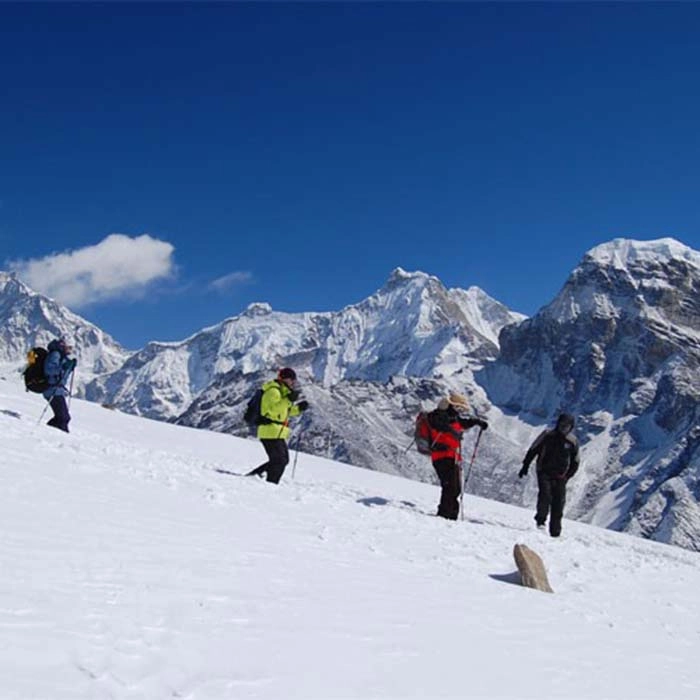







 Overviews
Overviews
 Trip Overview
Trip Overview
 Travel Itinerary
Travel Itinerary
 Cost Include
Cost Include
 Cost Exclude
Cost Exclude
 Fixed Departure
Fixed Departure
 Route Map
Route Map

 Freqeuntly Asked Questions
Freqeuntly Asked Questions
 Reviews And Rating
Reviews And Rating
